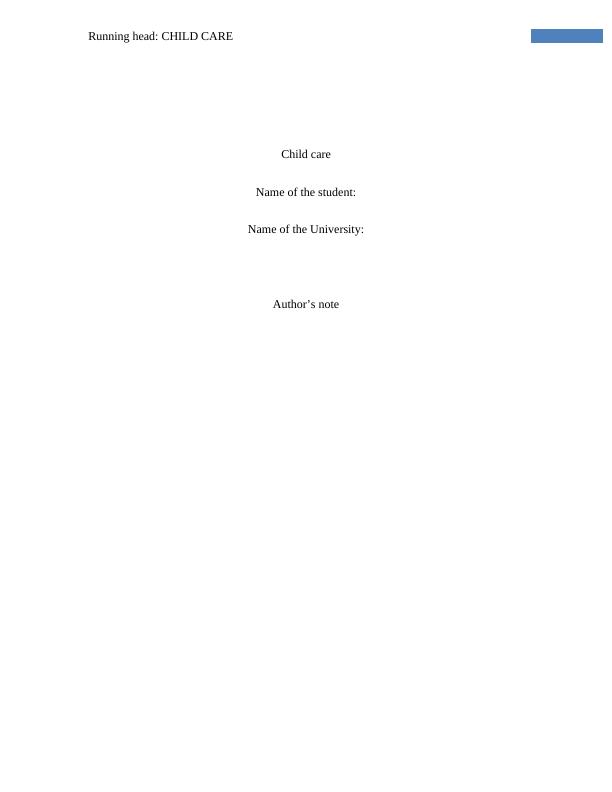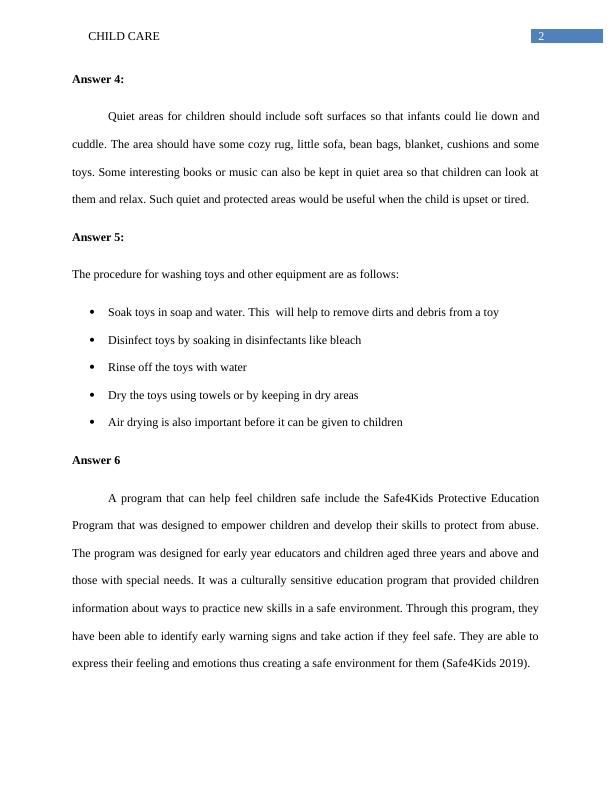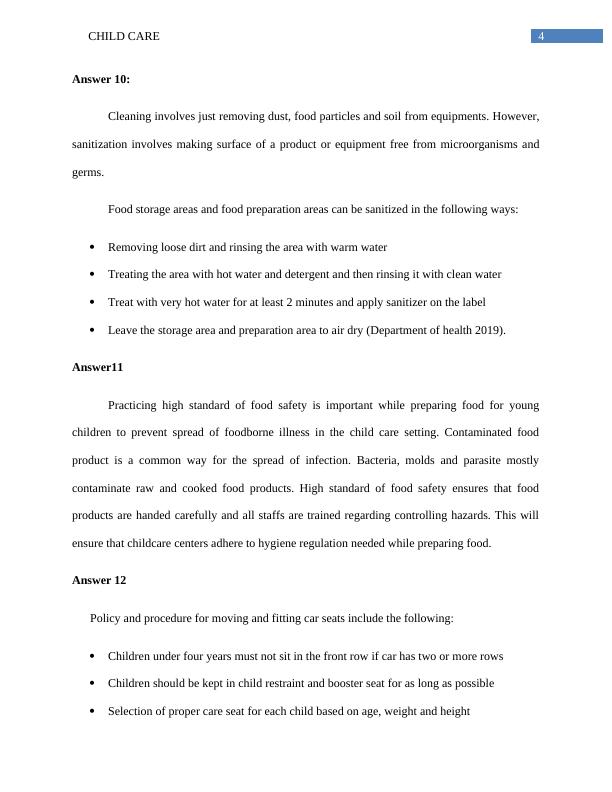Child Care: Safety Measures and Emergency Procedures
Added on 2023-04-21
27 Pages6185 Words252 Views
Running head: CHILD CARE
Child care
Name of the student:
Name of the University:
Author’s note
Child care
Name of the student:
Name of the University:
Author’s note

1CHILD CARE
Answer 1:
During enrolment, educators should communicate with families regarding the behavior of
their child and express any concern related to child’s behavior or learning process. Regular
updates should also be provided regarding child’s interest, learning needs, learning progress and
uniqueness. This makes families understand how their child is learning and the child is using her
imagination and interest to progress further. Communication related to the type of treatment
given to each child and the skills children have gained through the curriculum is also given to
families (Morrison, Storey and Zhang 2015).
Answer 2
Rest and sleeping areas should be provided to children attending a service provider so
that their relaxation needs are met. Different child have different sleep patterns and maintaining
regularity of sleep is important in early childhood education and care services (Carissimi et al.
2016). Some children have multiple sleeps throughout the days and having a sleep area can help
to appropriately respond to child’s sleep and relaxation needs
Answer 3
The rest areas for babies and older children may vary for different age group. In case of
infants, the rest areas should have labeled crib and crib sheets for individual babies. The napping
area should be separate from the play area and the sheets should be washed every week. For
toddlers and preschoolers, the napping area should have a mat or cot. In addition, blankets,
pillows and dim light should be provided so that soothing environment is provided to child
during sleep.
Answer 1:
During enrolment, educators should communicate with families regarding the behavior of
their child and express any concern related to child’s behavior or learning process. Regular
updates should also be provided regarding child’s interest, learning needs, learning progress and
uniqueness. This makes families understand how their child is learning and the child is using her
imagination and interest to progress further. Communication related to the type of treatment
given to each child and the skills children have gained through the curriculum is also given to
families (Morrison, Storey and Zhang 2015).
Answer 2
Rest and sleeping areas should be provided to children attending a service provider so
that their relaxation needs are met. Different child have different sleep patterns and maintaining
regularity of sleep is important in early childhood education and care services (Carissimi et al.
2016). Some children have multiple sleeps throughout the days and having a sleep area can help
to appropriately respond to child’s sleep and relaxation needs
Answer 3
The rest areas for babies and older children may vary for different age group. In case of
infants, the rest areas should have labeled crib and crib sheets for individual babies. The napping
area should be separate from the play area and the sheets should be washed every week. For
toddlers and preschoolers, the napping area should have a mat or cot. In addition, blankets,
pillows and dim light should be provided so that soothing environment is provided to child
during sleep.

2CHILD CARE
Answer 4:
Quiet areas for children should include soft surfaces so that infants could lie down and
cuddle. The area should have some cozy rug, little sofa, bean bags, blanket, cushions and some
toys. Some interesting books or music can also be kept in quiet area so that children can look at
them and relax. Such quiet and protected areas would be useful when the child is upset or tired.
Answer 5:
The procedure for washing toys and other equipment are as follows:
Soak toys in soap and water. This will help to remove dirts and debris from a toy
Disinfect toys by soaking in disinfectants like bleach
Rinse off the toys with water
Dry the toys using towels or by keeping in dry areas
Air drying is also important before it can be given to children
Answer 6
A program that can help feel children safe include the Safe4Kids Protective Education
Program that was designed to empower children and develop their skills to protect from abuse.
The program was designed for early year educators and children aged three years and above and
those with special needs. It was a culturally sensitive education program that provided children
information about ways to practice new skills in a safe environment. Through this program, they
have been able to identify early warning signs and take action if they feel safe. They are able to
express their feeling and emotions thus creating a safe environment for them (Safe4Kids 2019).
Answer 4:
Quiet areas for children should include soft surfaces so that infants could lie down and
cuddle. The area should have some cozy rug, little sofa, bean bags, blanket, cushions and some
toys. Some interesting books or music can also be kept in quiet area so that children can look at
them and relax. Such quiet and protected areas would be useful when the child is upset or tired.
Answer 5:
The procedure for washing toys and other equipment are as follows:
Soak toys in soap and water. This will help to remove dirts and debris from a toy
Disinfect toys by soaking in disinfectants like bleach
Rinse off the toys with water
Dry the toys using towels or by keeping in dry areas
Air drying is also important before it can be given to children
Answer 6
A program that can help feel children safe include the Safe4Kids Protective Education
Program that was designed to empower children and develop their skills to protect from abuse.
The program was designed for early year educators and children aged three years and above and
those with special needs. It was a culturally sensitive education program that provided children
information about ways to practice new skills in a safe environment. Through this program, they
have been able to identify early warning signs and take action if they feel safe. They are able to
express their feeling and emotions thus creating a safe environment for them (Safe4Kids 2019).

3CHILD CARE
Answer 7:
The plan could be adjusted to meet the need of preschool children by adjusting to the age
of preschool children and considering the supervision needs and kinds of harm preschool
children are exposed to. For preschool children, the nature of supervision will change as staff
needs to be more attentive with preschool children. The resource related plan for supervision will
also change in case of preschool children.
Answer 8:
If I detect a broken glass in the play area, then my strategy will be to remove all the
children from the play area and call the staffs to clean the area. I will also do thorough inspection
of the play area to identify pieces of glass which might harm children and lead to injury. I will
also ask children not to take off their shoes until the site is inspected to avoid risk of cut or
injuries due to broken glass.
Answer 9
To provide guidance to children on the safe use of equipments, the following steps can be
taken:
Introduce the equipment to the child
Demonstrate possible areas or materials in the equipment which could lead to injury
Demonstrate behaviors which could lead to injury
Teach children about proper handling of equipments to prevent injury
Teach children to report about any injury on time
Provide information about ground rules related to patient safety
Answer 7:
The plan could be adjusted to meet the need of preschool children by adjusting to the age
of preschool children and considering the supervision needs and kinds of harm preschool
children are exposed to. For preschool children, the nature of supervision will change as staff
needs to be more attentive with preschool children. The resource related plan for supervision will
also change in case of preschool children.
Answer 8:
If I detect a broken glass in the play area, then my strategy will be to remove all the
children from the play area and call the staffs to clean the area. I will also do thorough inspection
of the play area to identify pieces of glass which might harm children and lead to injury. I will
also ask children not to take off their shoes until the site is inspected to avoid risk of cut or
injuries due to broken glass.
Answer 9
To provide guidance to children on the safe use of equipments, the following steps can be
taken:
Introduce the equipment to the child
Demonstrate possible areas or materials in the equipment which could lead to injury
Demonstrate behaviors which could lead to injury
Teach children about proper handling of equipments to prevent injury
Teach children to report about any injury on time
Provide information about ground rules related to patient safety

4CHILD CARE
Answer 10:
Cleaning involves just removing dust, food particles and soil from equipments. However,
sanitization involves making surface of a product or equipment free from microorganisms and
germs.
Food storage areas and food preparation areas can be sanitized in the following ways:
Removing loose dirt and rinsing the area with warm water
Treating the area with hot water and detergent and then rinsing it with clean water
Treat with very hot water for at least 2 minutes and apply sanitizer on the label
Leave the storage area and preparation area to air dry (Department of health 2019).
Answer11
Practicing high standard of food safety is important while preparing food for young
children to prevent spread of foodborne illness in the child care setting. Contaminated food
product is a common way for the spread of infection. Bacteria, molds and parasite mostly
contaminate raw and cooked food products. High standard of food safety ensures that food
products are handed carefully and all staffs are trained regarding controlling hazards. This will
ensure that childcare centers adhere to hygiene regulation needed while preparing food.
Answer 12
Policy and procedure for moving and fitting car seats include the following:
Children under four years must not sit in the front row if car has two or more rows
Children should be kept in child restraint and booster seat for as long as possible
Selection of proper care seat for each child based on age, weight and height
Answer 10:
Cleaning involves just removing dust, food particles and soil from equipments. However,
sanitization involves making surface of a product or equipment free from microorganisms and
germs.
Food storage areas and food preparation areas can be sanitized in the following ways:
Removing loose dirt and rinsing the area with warm water
Treating the area with hot water and detergent and then rinsing it with clean water
Treat with very hot water for at least 2 minutes and apply sanitizer on the label
Leave the storage area and preparation area to air dry (Department of health 2019).
Answer11
Practicing high standard of food safety is important while preparing food for young
children to prevent spread of foodborne illness in the child care setting. Contaminated food
product is a common way for the spread of infection. Bacteria, molds and parasite mostly
contaminate raw and cooked food products. High standard of food safety ensures that food
products are handed carefully and all staffs are trained regarding controlling hazards. This will
ensure that childcare centers adhere to hygiene regulation needed while preparing food.
Answer 12
Policy and procedure for moving and fitting car seats include the following:
Children under four years must not sit in the front row if car has two or more rows
Children should be kept in child restraint and booster seat for as long as possible
Selection of proper care seat for each child based on age, weight and height

5CHILD CARE
Use knowledge of different seat belt systems to properly fit care seats
Training needs of staffs regarding fitting cars should be identified
Staffs need to be trained regarding restraint use and crash statistics, type of restraints and
accessories, legal standards for safety and training on safe installment of care seats and
restraints.
The policy can also educate staffs regarding the importance of selection of appropriate
child car restraints and learn the skills to identify hazards during transportation of child.
Answer 13:
While planning to arrange any excursion for children in child care setting, the child care
educator should inform families regarding the site and purpose of excursion. Parents should
be informed regarding reading consent form carefully and signing the form. Families should
also be informed regarding risk management plan and the preparation understands to reduce
any risk to child during the excursion. Families should be given adequate information so that
they can make informed decision regarding the participation of their child in excursion.
While advising parents regarding the excursion, details should be provided regarding time
and data of departure, destination, supervision available, details of activities, names of
teachers accompanying the excursion, cost involved and special rules related to the excursion
(Department of Education 2019)
Answer 14:
The details about the excursion can be distributed by attaching excursion detail in the daily
worksheet of children or by calling up families and asking them to visit the setting. On families
visit, they may be informed about the excursion in a face-to-face interaction.
Use knowledge of different seat belt systems to properly fit care seats
Training needs of staffs regarding fitting cars should be identified
Staffs need to be trained regarding restraint use and crash statistics, type of restraints and
accessories, legal standards for safety and training on safe installment of care seats and
restraints.
The policy can also educate staffs regarding the importance of selection of appropriate
child car restraints and learn the skills to identify hazards during transportation of child.
Answer 13:
While planning to arrange any excursion for children in child care setting, the child care
educator should inform families regarding the site and purpose of excursion. Parents should
be informed regarding reading consent form carefully and signing the form. Families should
also be informed regarding risk management plan and the preparation understands to reduce
any risk to child during the excursion. Families should be given adequate information so that
they can make informed decision regarding the participation of their child in excursion.
While advising parents regarding the excursion, details should be provided regarding time
and data of departure, destination, supervision available, details of activities, names of
teachers accompanying the excursion, cost involved and special rules related to the excursion
(Department of Education 2019)
Answer 14:
The details about the excursion can be distributed by attaching excursion detail in the daily
worksheet of children or by calling up families and asking them to visit the setting. On families
visit, they may be informed about the excursion in a face-to-face interaction.

End of preview
Want to access all the pages? Upload your documents or become a member.
Related Documents
Childcare: Transition from home to care, sleep routines, cultural needs, hygiene, nutrition, safety, and educator-child relationshiplg...
|5
|2202
|176
CHC30113 Certificate III in Early Childhood Education and Carelg...
|2
|554
|28
Hygiene Procedures, Immunisation Recommendations, Risk Minimisation Plan, and Emergency Procedures for Child Care Centerlg...
|8
|3035
|204
CHCECE005 Provide care for babies and toddlerslg...
|38
|8590
|277
Establish and Develop Health and Safetylg...
|8
|1589
|55
CHCECE005 Provide Care for Babies and Toddlers - Assessmentlg...
|23
|3883
|470
